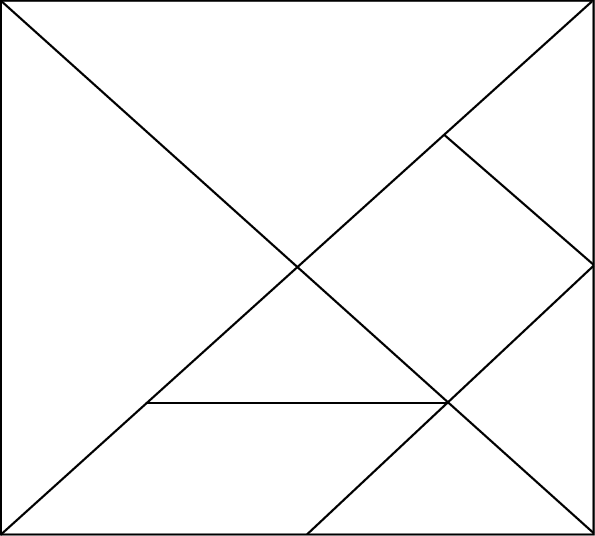| << Chapter < Page | Chapter >> Page > |
4.1 Turn what’s left of the sheet of paper over. Put the tangram together again to form the original square without looking at the second tangram. Now turn the paper over again and see if you did it correctly.
4.2 Now use the shapes to make:
4.3 Show your friends what you have made and discuss what you and they have made.
4.4 Paste your best one on paper and use it to decorate the classroom.
TANGRAMS FOR CUTTING OUT


5. Study the triangles in the table.
Triangle

Number of sides: ……..
Length:
none the same
Number of angles:……..
Size of angles:
none the same

Number of sides: ……..
Length:
none the same
Number of angles:……….
Size of angles:
none the same

Number of sides: ………
Length:
none the same
Number of angles:………
Size of angles:
none the same

Number of sides: ……..
Length:
none the same
Number of angles:……….
Size of angles:
none the same

Number of sides:………
Length:
none the same

Number of sides: ……….
Length:
none the same
Number of angles:………
Size of angles:
none the same
5.3 Use the squared paper on the rest of this page to make as many triangles with different shapes as you can.
6. You know a square and a rectangle. Here are some more QUADRILATERALS: You do NOT need to know their names.

6.1 Use the squared paper on the rest of the page to draw as many different quadrilaterals as you can. Begin with a square and a rectangle.
6.2 Compare their sides and angles and encircle the correct statements.
| Shape | Sides | Angles (corners) |
| Rectangle | Number of sides: ……………Length of sides:
|
Number of angles: …………...Size of angles:
|
| Square | Number of sides: ……………Length of sides:
|
Number of angles: …………...Size of angles:
|
| Parallelogram | Number of sides: ……………Length of sides:
|
Number of angles: …………...Size of angles:
|
| Shape | Sides | Angles (corners) |
| Rhombus | Number of sides: ……………Length of sides:
|
Number of angles: …………...Size of angles:
|
| Trapezium | Number of sides: ……………Length of sides:
|
Number of angles: …………...Size of angles:
|
| Kite | Number of sides: ……………Length of sides:
|
Number of angles: …………...Size of angles:
|
6.3 Discuss with your friends:
a) Is a square a special rectangle?
b) Is a square a parallelogram?
c) Is a rectangle a parallelogram?
d) What is a quadrilateral?
8. Why is a circle not a polygon?
9. What is the geometrical name for these objects:
9.1

9.2

9.3 a golf ball
10 How many faces (surfaces) has a cube of sugar?
11. Describe in one word the surface of a sphere.
12. Choose the correct word and underline it: The surface of the sun is curved / flat.
13. How many surfaces has a tetrahedron (3-sided pyramid)?
| LO 3 |
| space and shape (geometry)The learner will be able to describe and represent characteristics and relationships between two-dimensional shapes and three-dimensional objects in a variety of orientations and positions. |
| We know this when the learner: |
3.1 recognises, visualises and names two-dimensional shapes and three-dimensional objects in the environment including:
|
3.2 describes, sorts and compares two-dimensional shapes and three-dimensional objects from the environment according to geometrical properties including:
|
ACTIVITY 1 3D objects
1. Study
2. Drawings; sphere; cube; cylinder; cone; cuboid/ rectangular prism; cuboid; pyramid
3.1 and 3.2
| Sphere | Cylinder | Cube | Cuboid | Pyramid | Cone |
| Orange | Spaghetti | Ice block | Book | Box of chocolates | Ice-cream cone |
| All balls | Candle | Dice | Brick | Paper hat | |
| Rake handle | margarine | ||||
4.1 cuboid
4.2 cylinder
4.3 cone
4.4 cone
4.5 cuboid
5. Table
| Object | Number of surfaces | Flat or curved surfaces | Shape of surfaces |
| Box | 6 | flat | Rectangle |
| ball | 1 | curved | Sphere |
| cube | 6 | flat | Square |
| candle | 3 | Sides: curved | Cylindrical |
| pyramid | 3 or 4 | flat | Sides: triangular;Base: triangular or square |
ACTIVITY 2 2D shapes
1. Polygons: own
2.1 Circles: polygons have straight edges; circles are curved
2.2 It has a curved edge.
3.1 to 3.5 own
4.1 to 4.4 own
5.1 and 5.2
| Triangle | Sides | Corners/ Angles |
| 3all the same | 3all the same | |
| 32 the same | 32 the same | |
| 32 the same | 3 2 the same | |
| 3none the same | 3none the same | |
| 3none the same | 3 none the same | |
| 3none the same | 3none the same |
6.3 (a) yes
(b) yes
(c) yes
(d) It is a closed, flat 4-sided figure with straight sides.

Notification Switch
Would you like to follow the 'Mathematics grade 4' conversation and receive update notifications?